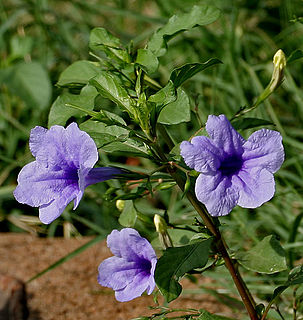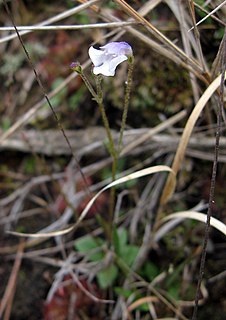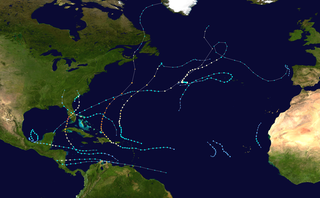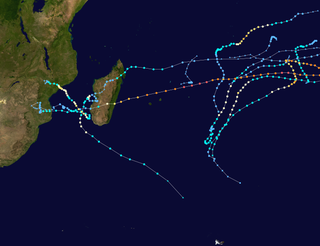
In meteorology, a cyclone is a large air mass that rotates around a strong center of low atmospheric pressure, counterclockwise in the Northern Hemisphere and clockwise in the Southern Hemisphere as viewed from above. Cyclones are characterized by inward-spiraling winds that rotate about a zone of low pressure. The largest low-pressure systems are polar vortices and extratropical cyclones of the largest scale. Warm-core cyclones such as tropical cyclones and subtropical cyclones also lie within the synoptic scale. Mesocyclones, tornadoes, and dust devils lie within smaller mesoscale. Upper level cyclones can exist without the presence of a surface low, and can pinch off from the base of the tropical upper tropospheric trough during the summer months in the Northern Hemisphere. Cyclones have also been seen on extraterrestrial planets, such as Mars, Jupiter, and Neptune. Cyclogenesis is the process of cyclone formation and intensification. Extratropical cyclones begin as waves in large regions of enhanced mid-latitude temperature contrasts called baroclinic zones. These zones contract and form weather fronts as the cyclonic circulation closes and intensifies. Later in their life cycle, extratropical cyclones occlude as cold air masses undercut the warmer air and become cold core systems. A cyclone's track is guided over the course of its 2 to 6 day life cycle by the steering flow of the subtropical jet stream.

The tropics are the regions of Earth surrounding the Equator. They are defined in latitude by the Tropic of Cancer in the Northern Hemisphere at 23°26′10.7″ (or 23.43632°) N and the Tropic of Capricorn in the Southern Hemisphere at 23°26′10.7″ (or 23.43632°) S. The tropics are also referred to as the tropical zone and the torrid zone.

The Scrophulariaceae are a family of flowering plants, commonly known as the figwort family. The plants are annual and perennial herbs, as well as shrubs. Flowers have bilateral (zygomorphic) or rarely radial (actinomorphic) symmetry. The Scrophulariaceae have a cosmopolitan distribution, with the majority found in temperate areas, including tropical mountains. The family name is based on the name of the included genus Scrophularia L.
Météo-France is the French national meteorological service.

Ruellia is a genus of flowering plants commonly known as ruellias or wild petunias. They are not closely related to petunias (Petunia) although both genera belong to the same euasterid clade. The genus was named in honor of Jean Ruelle (1474–1537), herbalist and physician to Francis I of France and translator of several works of Dioscorides.

A tropical cyclone is a rapidly rotating storm system characterized by a low-pressure center, a closed low-level atmospheric circulation, strong winds, and a spiral arrangement of thunderstorms that produce heavy rain and squalls. Depending on its location and strength, a tropical cyclone is referred to by different names, including hurricane, typhoon, tropical storm, cyclonic storm, tropical depression, or simply cyclone. A hurricane is a strong tropical cyclone that occurs in the Atlantic Ocean or northeastern Pacific Ocean, and a typhoon occurs in the northwestern Pacific Ocean. In the Indian Ocean, south Pacific, or (rarely) South Atlantic, comparable storms are referred to simply as "tropical cyclones", and such storms in the Indian Ocean can also be called "severe cyclonic storms".

Linderniaceae is a family of flowering plants in the order Lamiales, which consists of about 25 genera and 265 species occurring worldwide. Vandellia micrantha is eaten in Laos, but tastes bitter. Best known are the wishbone flowers Torenia fournieri and Torenia thouarsii, which are used as bedding plants especially in the tropics. Micranthemum is sold as an aquarium plant when it is called 'baby tears'.
An Australian region tropical cyclone is a non-frontal, low-pressure system that has developed within an environment of warm sea surface temperatures and little vertical wind shear aloft in either the Southern Indian Ocean or the South Pacific Ocean. Within the Southern Hemisphere there are officially three areas where tropical cyclones develop on a regular basis: the South-West Indian Ocean between Africa and 90°E, the Australian region between 90°E and 160°E, and the South Pacific basin between 160°E and 120°W. The Australian region between 90°E and 160°E is officially monitored by the Australian Bureau of Meteorology, the Indonesian Meteorology, Climatology, and Geophysical Agency, and the Papua New Guinea National Weather Service, while others like the Fiji Meteorological Service and the United States National Oceanic and Atmospheric Administration also monitor the basin. Each tropical cyclone year within this basin starts on 1 July and runs throughout the year, encompassing the tropical cyclone season, which runs from 1 November and lasts until 30 April each season. Within the basin, most tropical cyclones have their origins within the South Pacific convergence zone or within the Northern Australian monsoon trough, both of which form an extensive area of cloudiness and are dominant features of the season. Within this region a tropical disturbance is classified as a tropical cyclone when it has 10-minute sustained wind speeds of more than 65 km/h (35 mph) that wrap halfway around the low level circulation centre, while a severe tropical cyclone is classified when the maximum 10-minute sustained wind speeds are greater than 120 km/h (75 mph).
The Tropical Airplay chart is a record chart published by Billboard magazine introduced in 1994. The first number-one song on the chart was "Quien Eres Tu" by Luis Enrique. Originally, rankings on the chart were determined by the amount of airplay a song received on radio stations that primarily played tropical music, namely music originating from the Spanish-speaking areas of the Caribbean such as salsa, merengue, bachata, cumbia, vallenato, and tropical fusions. Any song, regardless of its genre, was eligible for the chart if it received enough airplay from the panel of tropical music radio stations being monitored.
Lindernia montana is a plant species in the Linderniaceae family. It is most commonly seen in China, where many plants are named according to their appearances. Since Lindernia montana resembles the tail of dogs, so its Chinese name is "gou mao cao", which has the meaning of "grass that looks like dog's fur". For its unique appearance, its profile was once popularly printed on China, especially during the Ming Dynasty.

The genus Lindernia is a group of plants in the family Linderniaceae. They are native to warm regions in both the Eastern and Western Hemisphere.

The 2022 Pacific typhoon season is an ongoing event in the annual cycle of tropical cyclone formation, in which tropical cyclones form in the western Pacific Ocean. The season runs throughout 2022, though most tropical cyclones typically develop between May and October.
Cucullia antipoda is a species of moth in the family Noctuidae found in North America.

The 2022 Atlantic hurricane season is the current cycle of the annual tropical cyclone season in the Atlantic Ocean in the Northern Hemisphere. The season officially began on June 1, and will end on November 30. These dates, adopted by convention, historically describe the period in each year when most subtropical or tropical cyclogenesis occurs in the Atlantic Ocean. This year's first named storm, Tropical Storm Alex, developed five days after the start of the season, making this the first season since 2014 not to have a pre-season named storm. There have been fourteen named tropical storms so far in the season. Eight of them strengthened into a hurricane, and two reached major hurricane intensity.
Bonnaya is a genus of flowering plants belonging to the family Linderniaceae.
Hartliella is a genus of flowering plants belonging to the family Linderniaceae.

The 2021–22 South-West Indian Ocean cyclone season featured the record latest start for the first system to develop. Despite the late start, it was an above-average season that produced 12 named storms, with 5 becoming tropical cyclones. The season began on 15 November 2021, and ended on 30 April 2022, with the exception for Mauritius and the Seychelles, for which it ended on 15 May 2022. These dates conventionally delimit the period of each year when most tropical and subtropical cyclones form in the basin, which is west of 90°E and south of the Equator. However, tropical cyclones that form at any time between 1 July 2021 and 30 June 2022 will count towards the season total. Tropical and subtropical cyclones in this basin are monitored by the Regional Specialised Meteorological Centre in Réunion and unofficially by the Joint Typhoon Warning Center.

The 2022–23 South-West Indian Ocean cyclone season is an ongoing event of the annual cycle of tropical cyclone and subtropical cyclone formation. It will begin on 15 November 2022, and will end on 30 April 2023, with the exception for Mauritius and the Seychelles, for which it will end on 15 May 2023. These dates conventionally delimit the period of each year when most tropical and subtropical cyclones form in the basin, which is west of 90°E and south of the Equator. However, tropical cyclones can form year-round, and all tropical cyclones that will form between 1 July 2022 and 30 June 2023 will be part of the season. Tropical and subtropical cyclones in this basin are monitored by the Regional Specialised Meteorological Centre in Réunion and unofficially by the Joint Typhoon Warning Center.











